How Do Gymnosperms Differ from Angiosperms?
Gymnosperms are a group of seed-producing plants that do not form flowers or fruits. Instead, their seeds remain exposed on the surface of specialised structures such as scales or leaves. In many cases, these structures are organised into cones. Most gymnosperms plants are found in cooler regions, but some varieties also grow in warmer or drier climates. Let us explore their defining features, classifications, life cycle and gymnosperm plants examples in detail.
What are Gymnosperms?
The term “Gymnosperm” is derived from the Greek words “gymnos” meaning “naked” and “sperma” meaning “seed.” Thus, they are referred to as “naked seeds.” Their seeds are not enclosed by the walls of an ovary or fruit, which distinguishes them from angiosperms. The fossil record suggests gymnosperms date back to the Palaeozoic Era, approximately 390 million years ago.
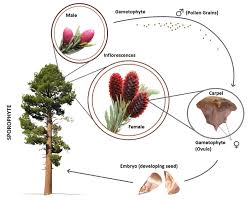
Key points about gymnosperms:
They produce seeds without forming flowers or fruits.
They often have tough, needle-like leaves with sunken stomata and a thick cuticle to minimise water loss.
Their reproductive structures are typically organised into cones (male and female).
Main Characteristics of Gymnosperms
Non-flowering plants: They do not produce flowers and fruits.
Naked seeds: Seeds develop on cone scales or leaf-like structures without any protective covering like a fruit.
Adaptations: Many gymnosperms characteristics include needle-like leaves, thick cuticles and sunken stomata, particularly suited for colder or drought-prone regions.
Vascular system: They have well-developed vascular tissues (xylem and phloem). However, xylem generally lacks vessels (except in gnetophytes), and their phloem lacks companion cells.
Cones or strobili: The reproductive structures (male and female cones) typically bear sporangia where the spores and subsequently gametophytes are produced.
Pollination: Occurs mainly by wind as there is no stigma to receive pollen. Pollen grains directly reach the ovule through pollination.
Male gametes: The male gametophytes often produce two gametes, but only one is functional in most species.
Dioecious or monoecious: Some gymnosperms (such as cycads and Ginkgo) have separate male and female plants (dioecious), whereas others have both types of cones on the same plant (monoecious).
Classification of Gymnosperms
Gymnosperms are commonly classified into four groups:
Cycadophyta (Cycads)
These are mostly dioecious plants (separate male and female plants).
They have thick trunks, large compound leaves and small leaflets.
Mostly found in tropical and subtropical regions, though some adapt to arid or swampy environments.
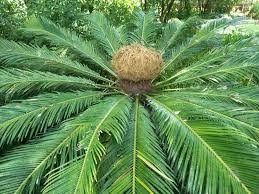
Ginkgophyta (Ginkgo)
This division has only one extant species: Ginkgo biloba.
Characterised by unique fan-shaped leaves.
Ginkgo biloba is resistant to pollution and has been known to survive extreme conditions.
Commonly used in traditional remedies for various memory-related conditions.
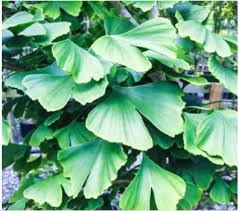
Gnetophyta (Gnetophytes)
Comprises a few remaining genera such as Gnetum, Ephedra and Welwitschia.
Their leaves may appear somewhat “flowery,” hinting at an evolutionary link to angiosperms.
Possess vessels in the xylem (a trait shared with angiosperms).
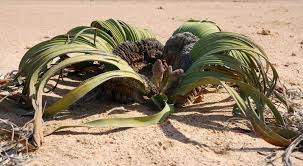
Coniferophyta (Conifers)
The largest group of gymnosperms, including pines, cedars, spruces and firs.
Generally evergreen, retaining leaves all year round.
Commonly found in temperate regions with moderate to cold climates.
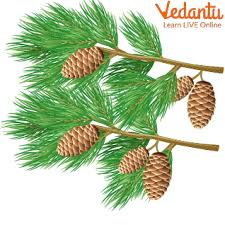
Gymnosperms Examples with Names
Here are some gymnosperm plants examples that you might come across:
Cycas
Pinus (pine)
Araucaria (monkey puzzle tree)
Thuja (arborvitae)
Cedrus (cedar)
Picea (spruce)
Abies (fir)
Juniperus (juniper)
Larix (larch)
Each of these gymnosperms examples with names highlights the diversity within this group. For instance, Pinus species are typically found in colder climates and often form extensive forests, while Cycas grows in tropical or subtropical environments.
Life Cycle of Gymnosperms
Gymnosperms exhibit alternation of generations, with a dominant sporophyte stage (diploid) and a shorter gametophyte stage (haploid). Their life cycle can be broadly outlined as follows:
Sporophyte generation: The main plant body is diploid (2n). Cones (strobili) appear, each bearing sporangia.
Male cone (microstrobilus): Contains microsporophylls with microsporangia, which produce haploid microspores. Some microspores develop into pollen grains (male gametophytes).
Female cone (megastrobilus): Bears megasporophylls with ovules containing megasporangia. These produce haploid megaspores; typically, one megaspore survives to form the female gametophyte.
Pollination: The wind carries pollen grains to the female cone.
Fertilisation: The male gamete (from pollen) fuses with the female gamete (egg) inside the ovule, forming a diploid zygote.
Seed formation: The fertilised ovule develops into a seed. These seeds rest openly on cone scales or leaf-like structures (hence “naked seeds”).
To learn more about another group of seed-producing plants that bear flowers, check our detailed article on Angiosperms. Also, read more about the Alternation of Generations in plants.
Unique Facts
Many conifers are economically important for timber, resin, paper production and ornamental use.
Ginkgo biloba is extremely resilient; after the Hiroshima nuclear bomb, a few Ginkgo trees near the blast site survived.
Cycads have motile sperm cells – a rather ancient feature, rarely found in modern seed plants.
Gymnosperm resin can protect against insects and fungal infections.
Mnemonics to Remember Gymnosperms
Here is a simple mnemonic to recall the four main divisions of gymnosperms:
“C G G C” – Cycadophyta, Ginkgophyta, Gnetophyta, Coniferophyta.
You might also modify it to something memorable like:
“Cool Green Giants Conquer” (representing Cycadophyta, Ginkgophyta, Gnetophyta, Coniferophyta).
Quiz on Gymnosperms (With Answers)
Try this short quiz to check your understanding:
1. Which group of gymnosperms includes Gnetum and Welwitschia?
A. Cycadophyta
B. Ginkgophyta
C. Gnetophyta
D. Coniferophyta
Answer: C. Gnetophyta
2. Why are gymnosperm seeds called “naked seeds”?
A. Because they lack a seed coat
B. Because they are not enclosed in an ovary or fruit
C. Because they grow in water
D. Because they lose their outer covering after fertilisation
Answer: B. Because they are not enclosed in an ovary or fruit
3. Which gymnosperm is known for fan-shaped leaves and resilience against pollution?
A. Pinus
B. Cycas
C. Ginkgo biloba
D. Cedrus
Answer: C. Ginkgo biloba
4. Which stage is dominant in the life cycle of gymnosperms?
A. Gametophyte (haploid)
B. Sporophyte (diploid)
C. Zygotic (diploid)
D. Prothallus (haploid)
Answer: B. Sporophyte (diploid)
Related Topics


FAQs on Gymnosperms: Meaning, Characteristics, Classification & Examples
1. What are gymnosperms and why are they called 'naked seed' plants?
Gymnosperms are a group of non-flowering, seed-producing plants. The name comes from the Greek words 'gymnos' (naked) and 'sperma' (seed). They are called 'naked seed' plants because their ovules, and the seeds that develop from them, are not enclosed within a protective ovary or fruit wall. Instead, the seeds lie exposed on the surface of structures like cone scales.
2. What are the main characteristics of gymnosperms?
The main characteristics of gymnosperms are:
- They are non-flowering plants and do not produce fruits.
- Their seeds are naked, meaning they are not enclosed within an ovary.
- They possess well-developed vascular tissues (xylem and phloem), although xylem typically lacks vessels and phloem lacks companion cells.
- Reproductive structures are usually organised into cones or strobili.
- Pollination occurs primarily through wind (anemophily).
3. How are gymnosperms classified according to the NCERT syllabus?
As per the CBSE 2025-26 syllabus, gymnosperms are primarily classified into four major divisions:
- Cycadophyta (Cycads): Palm-like plants with large compound leaves, such as Cycas.
- Ginkgophyta (Ginkgo): Represented by a single living species, Ginkgo biloba, known for its fan-shaped leaves.
- Gnetophyta (Gnetophytes): A diverse group including genera like Gnetum, Ephedra, and Welwitschia. They are unique for having vessels in their xylem.
- Coniferophyta (Conifers): The largest group, including evergreen trees like pines, cedars, and spruces, which are typically adapted to colder climates.
4. What are some common examples of gymnosperms?
Some common and well-known examples of gymnosperm plants include:
- Pinus (Pine): A common conifer found in temperate and cold regions.
- Cycas: A palm-like plant often found in tropical and subtropical areas.
- Ginkgo biloba: Known as the maidenhair tree, a living fossil.
- Cedrus (Cedar): An economically important tree valued for its wood.
- Picea (Spruce): Another common conifer used for timber and paper production.
5. How are gymnosperms adapted to survive in extreme climates like cold or drought?
Gymnosperms display several key adaptations for survival in harsh conditions. Their leaves are often needle-like, which reduces the surface area for water loss. They have a thick cuticle and sunken stomata, both of which help minimise transpiration. These features are crucial for conserving water in dry environments and preventing freezing damage in cold climates.
6. What is the key difference between the reproductive processes of gymnosperms and angiosperms?
The primary difference lies in the location of the ovules and the reproductive structures. In gymnosperms, the ovules are exposed on cone scales and pollination is direct, usually by wind. In contrast, angiosperms have ovules that are enclosed within an ovary inside a flower. Angiosperms often use diverse pollinators and undergo double fertilisation to form both an embryo and a nutritive endosperm, a feature absent in gymnosperms.
7. Why is the sporophyte generation dominant in the life cycle of a gymnosperm?
The sporophyte (2n) generation is dominant in gymnosperms because it is the main, long-lived, and photosynthetically independent plant body (e.g., the pine tree). The gametophyte (n) generation is highly reduced and nutritionally dependent on the sporophyte. This represents a major evolutionary advancement, as the larger, more complex sporophyte is better adapted for terrestrial life, while the dependent gametophyte is protected within its tissues.
8. What makes the xylem in most gymnosperms different from that in angiosperms?
The primary difference is in the water-conducting cells. The xylem of most gymnosperms lacks vessels and instead uses more primitive cells called tracheids for water transport. Angiosperm xylem, on the other hand, contains both tracheids and more efficient, wider vessels. An exception among gymnosperms is the group Gnetophyta, which has independently evolved vessel-like structures.
9. Why are certain features of Cycads, like motile sperm, considered primitive for seed plants?
The presence of motile, flagellated sperm cells in Cycads and Ginkgo is considered a primitive or ancestral trait. This is because it links them to their non-seed plant ancestors like ferns, which rely on water for the sperm to swim to the egg. More evolutionarily advanced seed plants, such as conifers and all angiosperms, have non-motile sperm delivered directly via a pollen tube, making them completely independent of water for fertilisation.
10. What is the economic importance of gymnosperms?
Gymnosperms, particularly conifers, hold significant economic value. Their wood is extensively used as timber for construction and furniture (e.g., pine, cedar). They are a primary source of pulp for paper production. Many species yield valuable products like resins and turpentine. Additionally, plants like Ginkgo biloba are used in traditional medicine, and many gymnosperms are cultivated as ornamental plants in parks and gardens.










